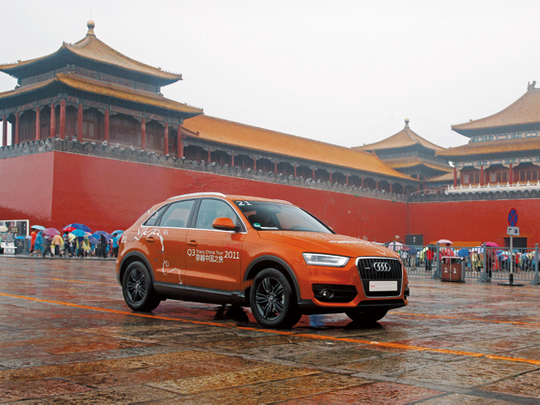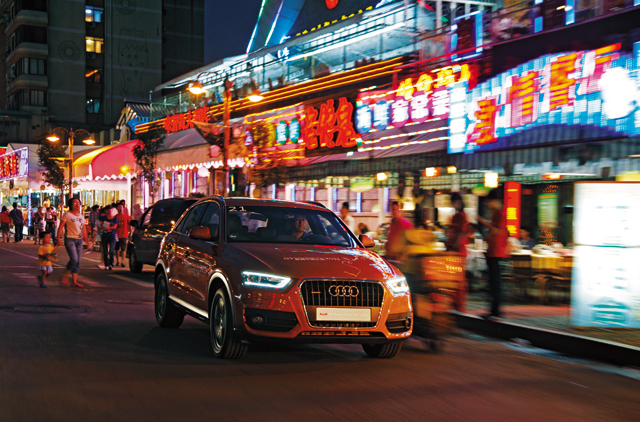
With the market for new vehicles in China currently at around 12 million units per year, it's practically the equivalent of all Western European markets combined. But such is the present growth in demand that next year sales are likely to be closer to 15 million units, and that's the equivalent of adding a market the size of Germany's to your sales figures in 12 months! So it's no surprise that manufacturers such as Audi have been making huge investments — and reaping equally large rewards — in the Chinese market over recent years.
In fact Audi, along with Volkswagen, has long had a presence in China in conjunction with its local joint-venture partners FAW, which first began assembling Audi 100s in the late Eighties. Having thus established itself early on in the premium-vehicle sector, Audi has subsequently gone on to become the single largest supplier of such vehicles in China.
To demonstrate just how important this ‘second home market' has become to the Ingolstadt manufacturer, Audi invited me to join its 2011 Trans China Tour, driving between the country's two most populous cities, Beijing and Shanghai. It was a chance not only to evaluate the Q3 crossover SUV, which Audi will soon begin manufacturing in its plant at Changchun, North West of Beijing, but also to see for myself just how the country is coping with its insatiable appetite for new vehicles.
We were warned at the first morning's briefing that driving standards would be ‘unlike anything you've ever seen before' so I must assume the gentleman giving the briefing has never been to the UAE (or Lebanon or India or Kenya or…) Many of those millions of new cars sold each year are being driven by millions of new and inexperienced drivers, leading to what the Chinese might call interesting times, but I thought of more as potentially life-threatening moments, out on the country's road network. The use of mirrors is clearly not taught, or perhaps just forgotten once the licence is issued, but that does mean I can report from first-hand experience that the Audi Q3's emergency braking in a very short distance at motorway speeds is satisfactory. Hopefully the seats, which proved comfortable for my weak back during days when we spent up to eight hours at the wheel, will also withstand regular dry-cleaning.
Now, the particular cars we were driving didn't have Audi's Active Lane Assist fitted. That system uses a camera mounted in the base of the rear-view mirror to detect when a driver moves out ofa marked lane without using his indicators. If he does so, the system nudges the steering wheel so as to keep the car in its lane, and can be set to vibrate to alert the possibly drowsy driver. In China though, the poor thing would be so overworked it would just throw in the towel. Hard though it may be to believe,I saw even fewer turn signals used in China than I see in the UAE. Who would have thought it possible?
But as we pulled excitedly away from downtown Beijing on our first day, all of these lessons were still to be learned, and anyway, we soon had a million other things to worry about. In the arcade game Asteroids, fast-moving objects, large and small, fly at you from every direction in an attempt to destroy you, and you never quite seem to have enough control over your vehicle to cope. That's pretty much what it's like crossing a major junction in Beijing (and Jinan and Nanjing and Shanghai and… repeat across China). Drivers will normally obey red lights but not always, whilst some vehicles pull up to your right at certain junctions in order to turn left across you.
Meanwhile, as far as the eye can see, thousands of pedestrians take their lives in their hands at crossings entirely ignored by every driver, especially those on nasty little electric scooters, which buzz around in every direction like agitated mosquitos at a picnic. As if this weren't enough to cope with, there appear to be six bicycles per square metre in Beijing, most of which have been converted into cargo-carrying light goods vehicles.
When we finally emerged, nerves jangling, from the downtown Beijing bedlam, we found ourselves on motorways which, once clear of the city limits (it takes quite a while!), were surprisingly free of traffic, so we could at last make rapid progress. There are, however, enough radar traps to keep you on your toes, and a disconcerting number of overhead flashguns which are not cameras, just highly effective speed warning devices; every time you see one triggered, a pang of guilt races across your mind and you back off a little.
Backing off happens quite frequently too. For example when you are carefully watching every movement of two trucks ahead of you, momentarily distracting you from the single diminutive traffic cone placed in the centre of the outside lane, which is there to indicate that the lane is closed, because 80 metres ahead, three men are standing atop a bamboo scaffolding rig placed under the shadow of a bridge. As I said, those brakes need to be good. The problem is that on Chinese roads, there are an awful lot of things competing for your urgent attention — even the road structures themselves. For example the 7.6km undersea tunnel at Qingdao or, en route to Nanjing, the world's longest bridge built over water, spanning an incredible 42.58km. ‘Impressive' doesn't begin to do it justice.
The Chinese government aims to build an astonishing 85,000km of expressways to connect every city with a population of 200,000 or more by the year 2035 and given the rate of construction we saw during our five days on the road, I don't doubt they'll succeed.
It's true that we did see a lot of other Audis on the motorways, and at rest stops and petrol stations it was primarily drivers of the Ingolstadt brand who would enquire about the cost of the Q3, so there seems to be a strong loyalty to the marque.
I learned from Dominique Boesch, president of Audi's sales division in China, that many car owners in China employ drivers, rather than drive themselves; almost certainly to preserve their own nerves! Consequently you'll see large numbers of an Audi model unique to China, the A6L, a stretched version of the four-door saloon, tailor-made to suit local requirements, with more legroom in the back for the owner.
Back out on the road, the Q3 proved to be a nimble enough performer, fitted as it is with the same two-litre turbo engine found in the VW Tiguan, though supplied to Audi's own specifications. As usual, Audi has managed to build the interior from similar materials to most other manufacturers yet somehow give the interior a look and feel that raises it a cut above the rest. There's sufficient room in the back for a taller passenger like me, though in a smaller SUV that inevitably means reduced boot space; with two medium-sized suitcases on board we were pretty much fully loaded, and even that meant removing the parcel shelf.
Unfortunately we had no opportunity to test the vehicle off road, though with only 170mm ground clearance this is a vehicle designed, as you would expect at this level, for the rough and tumble of potholed side roads, not necessarily the deserts of Gobi or Liwa. Should you head off in search of the Gobi though, you'll be pleased to know that Audi has developed an astonishing navigation system. Capable of identifying up to 29,000 local characters, it even features handwriting recognition to allow direct text entry,and has to cope with a road network which in the largest cities, features multi-deck highways stacked up to four high in places. I have to admit I put this process to the test by inadvertently leaving a raised highway one exit early, but staying on the same route, directly underneath the intended road. The navigation screen darkened a little which confused me at first, but is done I think, to simulate the fact that you are driving in the shadow of the road above. It's a cleverly devised method of keeping a driver accurately informed, which quickly earned my approval when it put me back on track.
Clearly the trip was not just about the driving itself; we were also fortunate enough to take in many sights and sounds of China's rural, historical and cultural elements. Less than an hour from the manic streets of Qingdao, for example,we literally drove into the middle ofa rural street market, so busy that people, along with produce and chickens destined to be that night's chop suey, spilled from roadside stalls to within inches of the car's bodywork. It was a different kind of mayhem to that in the big cities, but one I enjoyed and was privileged to have witnessed; as China's economic strength persists and its factories continue to tempt the younger generation from poorly paid farm work, scenes such as these will slowly become a thing of the past.
From the mostly elevated highways, it's easy to spot new China encroaching on the old. I was tempted to stop a dozen times a day to photograph paddy fields, tree-covered mountains and picturesque villages, yet there were times, driving for much of the 80km between Suzhou and Shanghai, for example, when all I saw was factories belching smoke and steam into the air, apartment blocks reaching ever higher, hundreds of freight yards, each corralling a dozen heavily loaded trucks and, inevitably, a huge number of new and used car showrooms.
Arriving in Shanghai at journey's end, and in a miraculously unscathed car, our final destination was a quayside overlooking Shanghai's truly spectacular skyline, a defining symbol of its new-found affluence. And as I sat on the harbour wall looking out across the Yangtze river,I couldn't help but wonder if the Emperors who had built and defended China's Great Wall, would be spinning in their ancestral graves knowing that the greatest danger now facing China's cities was no longer foreign militia, but a choking invasion driven aggressively onward by its own ambitious inhabitants.












